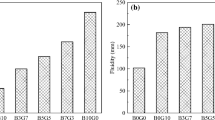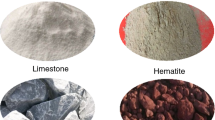Abstract
In this study, the reaction process of the MAPC coating system is investigated. And the delayed curing mechanism of borax in the coating hydration system is proposed. The results suggest that the research process of magnesium oxide-monoammonium phosphate-water diluted ternary suspension system is applicable for the MAPC coating reaction process, which can be divided into three stages: NH4H2PO4 dissolution, MgNH4PO4·6H2O primary crystallization and secondary crystallization. Borax can delay the setting and hardending time of MAPC, reduce the pH value and lower the hydration temperature without forming any new hydration product. Borax can improve the fluidity of MAPC coatings, and borax content has an effect on the compressive strength of MAPC hardened paste. The retarding effect is controlled by the formation and rupture of the protective film on the surface of MgO; the other is controlled by lowering the system temperature and adjusting the pH value of the coatings. In the hydration process, borax does not form new hydration products.








Similar content being viewed by others
References
Hou P, Li R, Li Q, Lu N, Wang K, Liu M, Cheng X and Shah S 2018 Novel superhydrophobic cement-based materials achieved by construction of hierarchical surface structure with FAS/SiO hybrid nanocomposites. ES Mater. Manuf. 1: 57–66.
Zhu S and Mai X 2019 A review of using reflective pavement materials as mitigation tactics to counter the effects of urban heat island. J. Adv. Compos. Hybrid Mater. 2: 381–388.
Ghahari S A, Ghafari E, Hou P and Lu N 2018 Hydration properties of cement pastes with al-zinc oxide and zinc oxide nanoparticles. ES Mater. Manuf. 2: 51–59.
Dong W, Li W, Vessalas K and Wang K 2018 Mechanical and conductive properties of smart cementitious composites with conductive rubber crumbs. ES Mater. Manuf. 2: 51–59.
Khater H M 2019 Valorization of cement kiln dust in activation and production of hybrid geopolymer composites with durable characteristics. Adv. Compos. Hybrid Mater. 2: 301–311.
Guo Z and Tang Z 2021 Rheological properties of microcapsules asphalt mortar. Highway 12: 336–340.
Wang Y, Li P and Ning H 2010 Application of epoxy-coated reinforcing steel in concrete structure. Mater. Heat Treat. 39(10): 133–135.
Hu W, Huang J, Zhang X, Zhao S and Pei L 2020 A mechanically robust and reversibly wettable benzoxazine/epoxy/mesoporous TiO2 coating for oil/water separation. Appl. Surface Sci. 507: 145168.
Hao X, Chen S, Qin D, Zhang M and Lia W 2020 Antifouling and antibacterial behaviors of capsaicin-based pH responsive smart coatings in marine environments. Mater. Sci. Eng. C 108: 110361.
Dong M, Li Q, Liu H, Liu C and Guo Z 2018 Thermoplastic polyurethane-carbon black nanocomposite coating: fabrication and solid particle erosion resistance. Polymer 158: 381–390.
Chen Y, Ding L, Jiang B, Liu L, Du Y and Huang Y 2019 Excellent gas barrier properties PET film modified by silicone resin/sericite nanocomposite coatings. ES Mater. Manuf. 4: 58–65.
Iwe I A, Gosteva E A, Starkov V V, Sedlovets D M and Mong O 2019 Anti-glare coatings based on porous silicon structures. ES Mater. Manuf. 3: 47–51.
Dou W, Li W, Cai Y, Dong M and Wang X 2010 Improved corrosion resistance and increased hardness of copper substrates from Cu-Ni/Ni-P composite coatings. MRS Adv. 5: 2129–2137.
Zhu G Y, Ma Z D, Sun M and Zhang Y 2018 Preparation and characterization of ZnO/PVB anticorrosive coating in marine environment. Polymer 138: 203–210.
Du H-Y, An Y-L and Wei Y-H 2018 Nickel powders modified nanocoating strengthened iron plates by surface mechanical attrition alloy and heat treatment. Sci. Adv. Mater. 10: 1063–1072.
Zhang J, Zhang W and Wei L 2019 Alternating multilayer structural epoxy composite coating for corrosion protection of steel. Macromol. Mater. Eng. 304: 1900374.
Zhu G, Cui X, Zhang Y, Chen S and Dong M 2019 Poly(vinyl butyral)/graphene oxide/poly (methylhydrosiloxane)nanocomposite coating for improved aluminum alloy anticorrosion. Polymer 172: 415–422.
Ahmad M R and Chen B 2020 Microstructural characterization of basalt fiber reinforced magnesium phosphate cement supplemented by silica fume. Constr. Build. Mater. 237: 117795.
Xie Y, Lin X, Li H and Ji T 2020 Effect of polyvinyl alcohol powder on the bonding mechanism of a new magnesium phosphate cement mortar. Constr. Build. Mater. 239: 117871.
Zhang X, Riaz A M and Chen B 2020 Numerical and experimental investigation of the hygrothermal properties of corn stalk and magnesium phosphate cement (MPC) based bio-composites. Constr. Build. Mater. 244: 118358.
Xu X, Lin X, Pan X, Ji T, Liang Y and Zhang H 2020 Influence of silica fume on the setting time and mechanical properties of a new magnesium phosphate cement. Constr. Build. Mater. 235: 117544.
Zeng X and Yu H 2020 Review of studies on structural performance of basic magnesium sulfate cement concrete in China (2014–2019). Korean Soc. Civ. Eng. 24(5): 1524–1530.
Kim H, Han D, Kim K and Romero P 2020 Performance assessment of repair material for deteriorated concrete slabs using chemically bonded cement. Constr. Build. Mater. 237: 117468.
Jianming Y, Luming W, Cheng J and Dong S 2020 Effect of fly ash on the corrosion resistance of magnesium potassium phosphate cement paste in sulfate solution. Constr. Build. Mater. 237: 117639.
Jinhong X, Dawei Y and Lijiu W 2009 Research on hydration mechanism of magnesia phosphate cement. J. Wuhan Univ. Technol. Mater. Sci. Ed. 31(9): 259–264.
Chong L L, Yang J M and Shi C J 2017 Research on hydration mechanism of magnesia phosphate cement. Constr. Build. Mater. 10: 43–51.
Feng H, Li L L, Wang W Q and Cheng Z Q 2022 Mechanical properties of high ductility hybrid fibres reinforced magnesium phosphate cement-based composites. Compos. OMPOSITE Struct. 284(1): 115219.
Jiansen W, Yonghui S, Peng Y, Fang Y and Jianfeng P 2006 Modeling studies of the crystallization process of magnesium ammonium phosphate for wastewater treatment based on the PHREEQC Program. Acta Scientiae Circumstantiae 26(2): 208–213.
Postma D, Larsen F, Minh Hue N T, Duc M T, Viet P H, Nhan P Q and Jessen S 2007 Arsenic in groundwater of the Red River floodplain, Vietnam: controlling geochemical processes and reactive transport modeling. Geochimica et Cosmochimica Acta 71(21): 5054–5071.
Charlton S R and Parkhurst D L 2011 Modules based on the geochemical model PHREEQC for use in scripting and programming languages. J. Comput. Geosci. 37(10): 1653–1663.
Jun L, Yong-sheng J, Guodong H and Cheng J 2017 Retardation and reaction mechanisms of magnesium phosphate cement mixed with glacial acetic acid. RSC Adv. 7: 46852–46857.
Acknowledgements
The authors would like to express their appreciations to Science and Technology Program of Henan Province of China (172102210393; 182102210418), and Key scientific research projects of universities in Henan (19B560004; 20B560010), and Kaifeng Science and Technology Program of Kaifeng City of China (2107001; 1901023; 2004043), and Funding for the high-level scientific research team of Kaifeng university, and Funded by the science and technology platform of Kaifeng University collaborative innovation center for new energy-saving building materials, and Research Fund project of Kaifeng University(KDBS-2020-1). The authors would like to express their appreciations to Kaifeng innovative science and technology team project and Kaifeng science and technology innovation talent plan funded project.
Author information
Authors and Affiliations
Corresponding author
Rights and permissions
About this article
Cite this article
Li, J. Study on the hydration process and borax retarding mechanism of the magnesium ammonium phosphate cement-based coating system. Sādhanā 47, 147 (2022). https://doi.org/10.1007/s12046-022-01920-4
Received:
Revised:
Accepted:
Published:
DOI: https://doi.org/10.1007/s12046-022-01920-4




